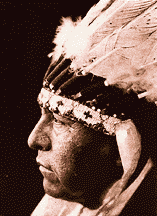
White Elk - Oto by E. S. Curtis
Oto Leaders
Choncape
Chonmanicase
or L'Ietan
Hayne Hudjihini
(Eagle of Delight)
Nowaykesugga
{oh'-toh}

Choncape
Chonmanicase
or L'Ietan
Hayne Hudjihini
(Eagle of Delight)
Nowaykesugga
The Oto, a tribe of North American Indians, lived in Wisconsin in prehistoric times. They spoke a Siouan language of the Hokan-Siouan stock. Along with the MISSOURI and the IOWA, they separated from the WINNEBAGO to settle near the Iowa River. After a factional fight on Grand River, the Oto went farther up the Missouri; in the late 18th century they numbered more than 1,000 in several villages along the Platte River in Nebraska. The Oto lived in oven-shaped earth houses when cultivating along the river but used tepees while on excursions into the plains to hunt bison. Society was organized in nine clans based on male ancestry, cut across by voluntary associations, such as the Medicine, Buffalo, and Curing Lodges. Mystical vision quests were important male rites.
Despite several peace treaties between 1817 and 1841, the Oto sometimes joined the OSAGE to raid in Nebraska. After the Civil War about 400 Oto and 50 Missouri moved onto a reservation in northwest Kansas, ceding much land in Nebraska. In 1881, ten years after their last bison hunt, they sold their reservation and moved to INDIAN TERRITORY, where they became members of the NATIVE AMERICAN CHURCH. Chief Whitehorse led the Oto during difficult days in Oklahoma. During World War I oil was discovered on their land, but its irregular production has failed to provide the Oto with a substantial income source. The Otoe-Missouria tribe numbered about 1,350 in 1991.
Dore and Wahredua
How the Man
got into the Moon
How
Too-loo-lah, the rainbow, got its colors
Rabbit
and Muskrat
Long ago, when man (which was called the two-legged creature) could talk to animals, there was peace. Everyone called one another "brother". One day in winter, man was waking up and saw bear. He asked, "Brother, where are you going?"
Bear answered, "I'm going fishing." Man asked if he could go too. Bear said, "Yes." So they went to the lake. When they got to the lake, bear told man not to try to fish because he did not have thick fur like bear. But man thought he could do it, so he jumped in. The water was freezing! Bear swam over and took man to shore. Bear covered man with his fur. Bear was mad! Man had not listened to him.
A few days later, all the animals had a meeting about man. They all agreed that man was not listening to them. Then dog said, "I will stay with man and keep him out of trouble."
Horse said, "I'll go, too." Then dog and horse went with man. So that is why the dogs and horses are good friends with humans.
Flag
of the Otoe-Missouria
Ioway-Otoe-Missouria
Language
Ioways Today
Lewis and Clark
to the Oto Indians
National
Geographic: Lewis & Clark—Tribes—Oto Indians
Notes on the
Oto by ES Curtis
Oto
Mission
Treaty
with the Oto & Missouri, 1833
![]() Return to Indigenous Peoples' Literature
Return to Indigenous Peoples' Literature
Compiled by:
Glenn Welker
Copyright Š 1993-2008
This page last updated 01/09/2008 11:09:39
This site has been accessed 10,000,000 times since February 8, 1996.